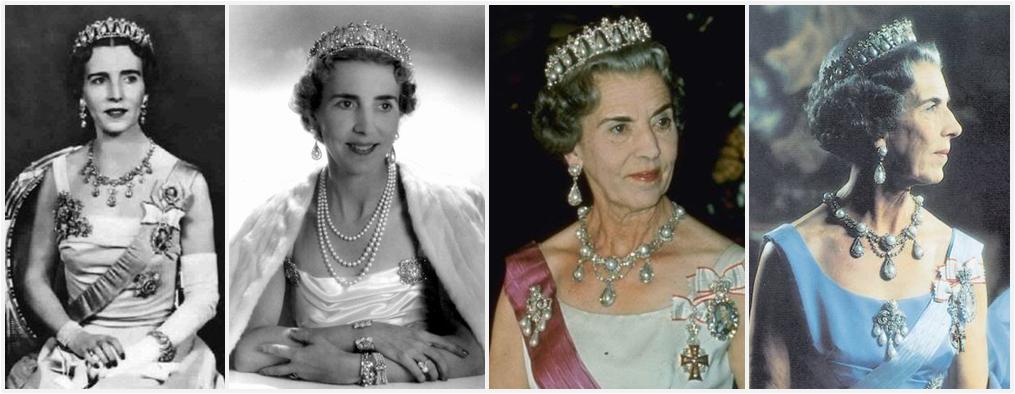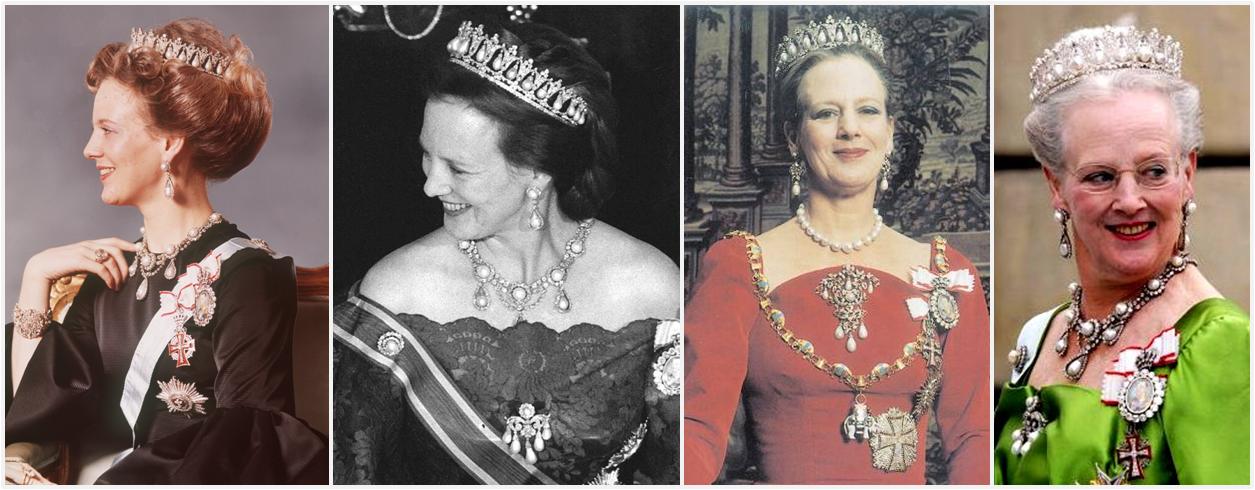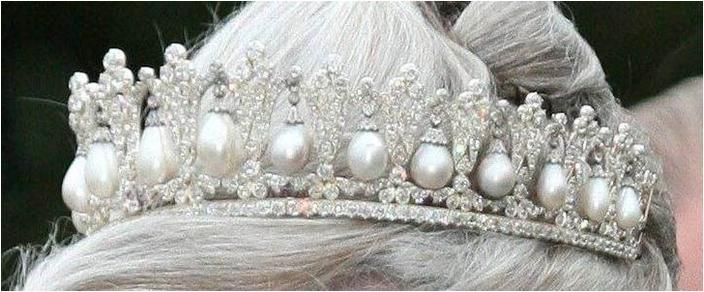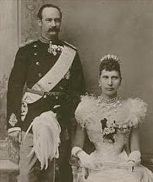Pearl Poiré Tiara and a Crown of Light
/Today is Luciadgen day (St. Lucy's Day). The girl chosen to represent St. Lucy wears a crown of candles so I thought that the Pearl Poiré Tiara from Denmark would be an appropriate piece to feature today.
Pearl Poiré Tiara
Queen Louise (with King Frederik VIII) in the Tiara
The tiara is thought to have been made around 1825 in Berlin at the request of King Friedrich Wilhelm III of Prussia. The tiara was a wedding gift for his daughter Louise, who was marrying Prince Frederik of the Netherlands. The tiara features 18 drop pearls (poiré pearls) dangling from tall diamond arches. The Prussian king also commissioned a look-alike tiara for his son Prince Albrecht's bride, Princess Marianne of the Netherlands; however, the second tiara's current whereabouts are unknown.
The current version of the (now) Danish tiara wandered through various Scandinavian royal owners before it found its home in Denmark. The original owner, Princess Louise (1808-1870), left the tiara to her oldest daughter, also named Louise, who was Queen of Sweden and Norway. Queen Louise (1828-1871) died shortly after inheriting the tiara and it then passed to her daughter, who was also named Louise (1851-1926). This Louise married the future King Frederik VIII of Denmark in 1869, and the tiara arrived at its final home. That is a lot of Louise's, I know!
Queen Louise of Denmark wore the tiara with a few other pearl and diamond pieces consisting of a demi-parure of a necklace and earrings (a wedding present from the Khedive of Egypt), and a brooch that came from her grandmother. The assembled parure (set) is still worn together today.
Louise made sure that the parure stayed in Denmark by leaving it to the Danish Royal Property Trust. This means the pieces are not the personal property of any particular royal, so they will pass from monarch to monarch without being sold. And so the parure has been worn by Louise's daughter-in-law Queen Alexandrine (1879-1952); Alexandrine's daughter-in-law Queen Ingrid (1910-2000); and Ingrid's daughter Queen Margrethe, who wears them today.


This tiara is frequently worn at the annual New Year's Court gala by Queen Margrethe. The tiara has also worn it to big events like her jubilee celebrations and Crown Princess Victoria's wedding. It also features prominently in many well-known portraits. The tiara is very rarely loaned as this is one of the pieces that has historically been kept for the queen. The exception was made for on the occasion of two British coronations: Ingrid, while still Crown Princess, at the 1937 coronation of George VI and Elizabeth, and Princess Margarethe at the 1953 coronation of Elizabeth II).
Luciadagen (Saint Lucia Day)
Luciadagen, or Saint Lucy's Day, is also called the Feast of Saint Lucy. It is a Christian feast day celebrated on December 13, in Advent and commemorates the martyr Saint Lucy who (according to legend) brought "food and aid to Christians hiding in the catacombs" using a candle-lit wreath to light her way while leaving her hands free to carry food. Her feast once coincided with the Winter Solstice, the shortest day of the year before calendar reforms, so her feast day has become a festival of light. St. Lucy's Day is also viewed as an event signaling the arrival of Christmastide.
St. Lucy’s Day is celebrated most commonly in Scandinavia, with their long dark winters. It is also popular in Italy, where it emphasizes a different aspect of the story.
Sankta Lucia by Carl Larsson
In Sweden, Denmark, Norway, and Finland, Lucia is venerated on December 13 in a ceremony where a girl is elected to portray Lucia. Wearing a white gown with a red sash and a crown of candles on her head, she walks at the head of a procession of women, each holding a candle. The candles symbolize the fire that refused to take St. Lucy's life when she was sentenced to be burned. The women sing a Lucia song while entering the room, to the melody of the traditional Neapolitan song Santa Lucia; the Italian lyrics describe the view from Santa Lucia in Naples, the various Scandinavian lyrics are fashioned for the occasion, describing the light with which Lucia overcomes the darkness. Each Scandinavian country has lyrics in their native tongues. In both Norway and Sweden, girls dressed as Lucy carry rolls and cookies in procession as songs are sung. Even boys take part in the procession as well, playing different roles associated with Christmas. After finishing this song, the procession sings Christmas carols or more songs about Lucia.
In Denmark, the Day of Lucy (Luciadag) was first celebrated on December 13, 1944. The tradition was directly imported from Sweden by initiative of Franz Wend, secretary of Föreningen Norden, as an attempt "to bring light in a time of darkness”. During the German occupation of Scandinavian countries during the Second World War it was widely regarded as a means of passive protest. Today schools and kindergartens also use the occasion to mark the event as a special day for children on one of the final days before the Christmas holidays.
There are also a number of additional historical traditions connected with the celebration, which are not widely observed. The night before candles are lit and all electrical lights are turned off, and on the Sunday closest to December 13 participants traditionally attend church.
Adèle Söderberg (1880-1915)
Sankta Lucia (Norwegian Lyrics)
Svart senker natten seg i stall og stuer.
Solen har gått sin vei, skyggene truer.
Inn i vårt mørke hus stiger med tente lys,
Sankta Lucia, Sankta Lucia!
Natten er mørk og stum. Med ett det suser
i alle tyste rom som vinger bruser.
Se på vår terskel står, hvitkledd med lys i hår,
Sankta Lucia, Sankta Lucia!
Saint Lucia (English translation)
Black night is falling in stables and homes.
The Sun has gone away, the shadows are threatening.
Into our dark house enters with lit candles,
Saint Lucia, Saint Lucia!
The night is dark and silent; suddenly a rush
in all quiet rooms, like the waving of wings.
See, at our threshold stands, dressed in white with lights in her hair,
Saint Lucia, Saint Lucia!
References: Wikipedia, The Royal Order of Sartorial Splendor
Kathleen Marino MA, GG, AJP, NAJA




















